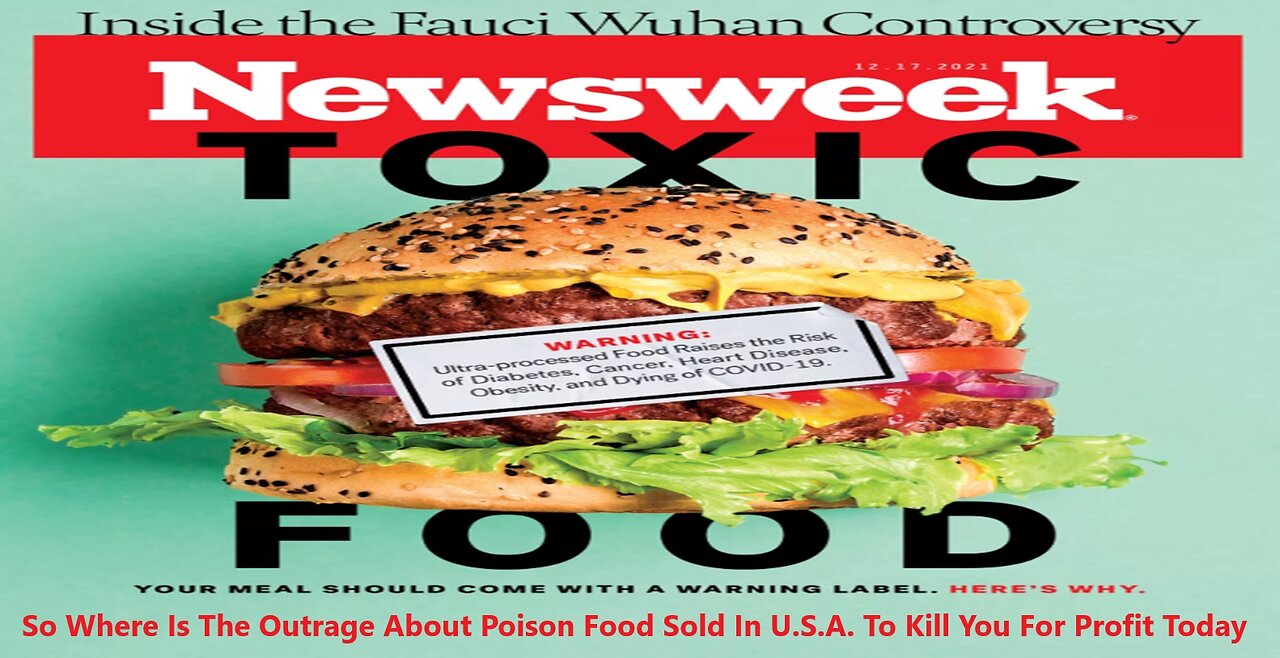Premium Only Content

So Where Is The Outrage About Poison Food Sold In U.S.A. To Kill You For Profit Today
Don't Drink It Ever! Let Me Show You Why You Shouldn't Consume It Ever... Most Soda Pop Brands. So Where Is The Outrage About Poison Food Sold In U.S.A. To Kill You For Profit Today. It also floods the bloodstream with glucose, causing insulin levels to spike. This high "glycemic load," a measure of how quickly blood sugar rises, can have long-term consequences for the way the body processes food, leading to a long-term dysregulation of the hormonal systems. These hormones tell the body to store more fat at the expense of providing calories to keep things running. The body, starved of energy, craves food—meaning we are forever hungry, even when we overeat.
Coca-Cola: One of the most well-known soft drink brands globally, recognized by 95% of internet respondents in the U.S. It is available in various flavors and formulations, including Coca-Cola Zero Sugar and Coca-Cola Cherry.
Pepsi: The second largest soda brand, with a brand awareness of 94% in the U.S. Pepsi offers a range of flavors such as Pepsi Max,
Diet Pepsi, and Pepsi Wild Cherry. PepsiCo, the company behind Pepsi, has a long history dating back to 1893.
Dr Pepper: A unique blend of 23 flavors, Dr Pepper has been growing in popularity, especially among Generation Z. It is owned by Keurig Dr Pepper and is recognized for its distinctive taste.
Sprite: A lemon-lime flavored soda with a 95% brand recognition in the U.S. Sprite has expanded its product line to include variants like Sprite Zero Sugar, Sprite Cranberry, and Sprite Tropical Mix.
7UP: Known for its lemon-lime flavor, 7UP is manufactured by Keurig Dr Pepper in the U.S. and by PepsiCo in other regions. It has a significant global presence, particularly strong in North America and parts of Europe.
Diet Coke: Introduced in 1982 as a sugar-free alternative to Coca-Cola, Diet Coke has a distinct flavor profile and has expanded to include flavors like Diet Coke Lime, Diet Coke Cherry, and Diet Coke Ginger Lime.
Mountain Dew: A popular citrus-flavored soda, Mountain Dew has various flavors and is owned by PepsiCo.
Fanta: A fruit-flavored soda available in over 190 countries, Fanta enjoys extensive global sales and strong brand recognition.
Diet Pepsi: A variant of Pepsi, Diet Pepsi is popular in the diet soda market and is available in various flavors.
Starry: A rebranded version of Sierra Mist, Starry is a regional soda that was previously widely available in certain areas.
These brands represent a diverse range of flavors and formulations, catering to different tastes and preferences across the globe.
Tens Of Millions Americans Are Addicted to 1,000+ Brands 'Ultra-Processed' Foods, and It's Killing Us Today In 2025.
Being severely overweight has never been so dangerous. During the COVID-19 epidemic, Americans who are obese, without any other risk factors, were hospitalized at three times the rate of those who weren't, by some estimates. When combined with other diet-related health conditions such as cardiovascular disease and diabetes, obesity raises the risk of hospitalization sixfold and the risk of death twelvefold.
Those numbers have raised the stakes in the nation's epidemic of diet-related disease and added to the growing alarm of politicians and nutrition experts, some of whom are starting to call upon regulators to rein in food companies. They're pushing measures similar to those used to curb the influence of tobacco companies in the 1990s, such as limiting the marketing of certain kinds of food to children and actively discouraging the consumption of key ingredients—chief among them, sugar.
At issue is the explosive growth in a broad class of food products that are not merely processed in the conventional sense to lengthen shelf life, but are also often modified to maximize flavor, visual appeal, texture, odor and the speed with which they are digested. These foods are made by deconstructing natural food into its chemical constituents, modifying them and recombining them into new forms that bear little resemblance to anything found in nature. So radically are they altered that nutrition scientists have given them a new name: ultra-processed.
Ultra-processed foods are often designed to directly target the vulnerabilities of the human brain—in particular, to exploit the way the brain processes pleasurable sensations. They often deliver a signal to the brain's reward centers so quick and potent, some neuroscientists believe, that many people find it as addictive as opioids or nicotine.
Lab-made creations such as chips, hot dogs, enriched bagels and American cheese have been a staple of the American diet since the 1980s. In recent years, however, the varieties of these foods have multiplied on store shelves and in fast-food restaurants. In 2017 and 2018, they accounted for 57 percent of the calories consumed by the average American—up from 54 percent in 2001 and 2002, according to one study.
"We've gotten really good at stripping out and refining and processing sugars and fats into these really potent vehicles, and they've gotten cheaper to make," says Ashley Gearhardt, a psychology professor at the University of Michigan who studies food and addiction. "Then we combine them into totally novel food products that are so much more rewarding than anything our brains ever evolved to handle. That's why so many of us can't stop eating them."
The implications are worrisome. Half of American adults now have diabetes or pre-diabetes, three quarters of adults are overweight and about 100 million, or 42 percent, are obese, by the standards of the Centers for Disease Control and Prevention (CDC). Among children between 2 and 5 years old, one in 10 are already obese. Among teens, that number is one in five.
Our food, in other words, is literally killing us. Food companies have tricked our brains into making us complicit, and our elected officials are complicit, too. What's needed is a better understanding of exactly how processed foods make us sick and a public reckoning with Big Food's role in the nation's health crisis. So far, policymakers have shown little appetite for scrutinizing the tactics of the powerful food lobby, but the pressure to curb consumption of ultra-processed foods is growing.
The nation's food crisis seems to be playing out in ways eerily reminiscent of the early days of tobacco smoking more than half a century ago, before regulators caught up with Big Tobacco. (It's no coincidence that many tobacco companies later acquired food companies.) This time, it's Big Food peddling harmful and possibly addictive products.
"We have now the accumulated evidence, particularly in the last five years, that people who eat more ultra-processed foods have higher risk of obesity, diabetes, cardiovascular diseases, depression, cancer, renal and liver diseases," says Marion Nestle, a professor emerita of nutrition, food studies and public health at New York University. "The studies have been overwhelming. There've been hundreds and hundreds of them. There's no doubt that this is not a good thing. It is a problem."
Proof of Harm
A few years ago, Kevin Hall set out to debunk the theory, espoused by a growing number of nutritionists, that Americans were getting fatter and sicker because of the complex industrial and chemical processing that food companies were using to make their products appealing. Hall believed the explanation had more to do with Americans simply eating too many calories, fats and sugars. The notion that extra processing might be causing the problem struck him as "ridiculous."
To prove it, Hall, who runs a research laboratory that studies the regulation of metabolism and body weight at the U.S. National Institutes of Health (NIH), ran a controlled experiment that he thought would show beyond a doubt that processing wasn't as important as nutrients. He paid 20 volunteers $5,000 apiece to move into an NIH facility in Bethesda, Maryland, for one month. He divided the volunteers into two groups. One ate mainly healthy food derived from simple ingredients with minimal processing, such as Greek yogurt, beef tender roast and shrimp scampi with spaghetti. The other group ate Honey Nut Cheerios, Chef Boyardee beef ravioli, Eggo pancakes and other processed foods—the kind most overweight people in America eat.
Hall and his colleagues did their best to ensure that the only significant difference between the two groups was in how much processed food they consumed. Each group ate diets that were nutritionally identical in every way Hall and his team could think of, containing the same amounts of sugar, salt, fat, fiber, macronutrients, carbohydrates and calories. Both groups of volunteers were allowed to eat as much as they wanted. After they finished a meal, their leftovers were carried down a couple floors and delivered to a team of nutritionists in a laboratory, who precisely weighed and characterized everything left on the plate.
Hall, it turns out, had it all wrong—processing, in fact, made all the difference. The subjects in Hall's study who subsisted on Cheerios and Chef Boyardee gained one pound per week on average and consumed in excess of 500 calories a day more than the group with the healthier diet. What's more, when they later switched to a natural diet, they dropped the extra weight. The conclusion: whatever food company chemists are doing to food, it makes people fatter.
The results opened up a new avenue of inquiry for Hall and his colleagues. What was it about the ultra-processed food that prompted this overindulgence and weight gain? The question is a matter of intense speculation and debate in the world of nutrition science—a debate that can only be solved with more research. What's clear, however, is that the ultra-processed foods favored by a vast proportion of Americans are causing harm.
The Two-Year Cupcake
Humans have been modifying food since hunter-gathers discovered fire and figured out how to barbeque stone-age animals. Ten thousand years ago, ancient Mesopotamians and Egyptians learned how to smoke, salt and dry their food to preserve it. In the 19th century, pasteurization and canning techniques vastly expanded the capacity for long-term storage and transport of food.
Processed food, as we know it today, arrived in the first half of the 20th century. That's when food engineers figured out how to use modified potato starch to form pork, ham, sugar, water and sodium nitrate into a pliable gelatinous blob that would fit into a rectangular tin emblazoned with the word "Spam." Two World Wars, the Space Race and increasing consumer demand for fast meals with a long shelf life that could support the lifestyle of the expanding middle class financed the scientific efforts necessary to give us spray drying, evaporation, freeze-drying and a sophisticated understanding of how to make a decent tasting cupcake you can put on a shelf and still eat two years later. By the early 2000s, Americans were getting more than half of their calories from chicken nuggets, artificially sweetened canned food, potato chips and other man-made concoctions.
Nutritionists didn't create a language to describe this trend until 2009. That year, Carlos A. Monteiro, a lanky, curly-haired professor of nutrition at the University of Sao Paulo, introduced the "NOVA Food Classification system," a novel grouping of foods based not on their nutritional content but according to the extent and purpose of the physical, biological and chemical processes applied to them after they were separated from nature.
He coined the term "ultra-processed," (as opposed to "minimally processed" or simply "processed") to refer to "industrial formulations made entirely or mostly from substances extracted from foods (oils, fats, sugar, starch and proteins), derived from food constituents (hydrogenated fats and modified starch), or synthesized in laboratories from food substrates or other organic sources (such as flavor enhancers, colors and food additives used to make the product hyper-palatable). Monteira excluded foods that had been exposed to simple processes like drying, fermentation, pasteurization or other processes that might subtract part of the food (frozen vegetables, dried pasta or eggs). He also carved out exceptions for products manufactured by industry with the use of salt, sugar, oil or other substances added to natural or minimally processed foods to preserve or to make them more palatable, but that could still be recognized as versions of the original foods—usually foods that had just two or three ingredients (such as beef jerky, or freshly made bread).
Ultra-processed food, by contrast, was meant to include Frankenstein-like creations that were often made up of added sugar, salt, fat and starches extracted from natural occurring foods and then blended with artificial colors, flavors and stabilizers to hold it all together. Soft drinks, hot dogs, cold cuts, packaged cookies and salty snacks like pretzel rods all qualified, as did many frozen dinners and canned entrees.
"They are not food," Monteiro says. "They are formulations. They contain chemical compounds that do not belong to food—that should not belong to foods."
Many researchers dismiss Monteiro's classification system as overly broad. The category of "ultra-processed foods," after all, encompasses a wide variety of different products with endlessly varied nutritional profiles. It lumps Twinkies, Doritos and diet soda together with protein-rich entrees like Perdue Chicken tenders, which are made from the rib meat of an actual chicken and then combined with dextrose, sugar, guar gum, yellow corn flour and other ingredients, and Hormel Beef and bean chili, made from actual beef, beans and crushed tomatoes and combined with less than 2 percent modified cornstarch, soy flour and caramel color.
Nonetheless, by defining a new category that represents levels of processing, he gave public health experts and epidemiologists the language to discuss how industrial chemists had changed food—and how to measure their inventions against a wide array of health problems. The strength of those associations soon began to generate attention.
Toxic Sugar
Although scientists haven't figured out how ultra-processed foods cause people to gain weight—which of the thousands of chemicals, additives, nutrients actually lead to worse health outcomes—the market forces that have guided food manufacturers are clear enough. Between 1980 and 2000, the period in which obesity and metabolic diseases began to rocket upwards, the number of calories available for purchase in the U.S. food supply increased 20 percent, from about 3,200 per person per day to 4,000, which dramatically increased competition for the limited attention and stomach capacity of the American consumer.
Nestle, the author of many books on the politics of food policy, suggests that federal farm subsidies that ensured surplus crops, such as corn, made it to market, along with the widespread adoption of cheap additives in the 1970s like high fructose corn syrup, were among the factors that drove this overproduction. Meanwhile in the 1980s, activist stockholders stepped up pressure on food companies to grow their quarterly growth profits to keep the stock prices rising. All of this fueled a high-stakes arms race in the food industry between competing product development and marketing teams.
"If you're trying to sell your food product and make a profit in an environment in which there's twice as many calories as anybody needs," says Nestle, "you either have to get people to buy yours instead of somebody else's or to get everybody to eat more in general."
To sell more, food companies made their products ubiquitous. They sold them in bookstores and libraries. They set up in clothing stores, drugstores and gas stations. They offered up bigger portions and created more cartoon characters to sell cereal, using tactics pioneered and perfected by Big Tobacco, which by then had begun to diversify from cigarettes into food. They also called in scientists, who helped devise ingenious marketing techniques and scientific innovations to sell more food.
Michael Moss devotes a chapter of his 2013 book Salt Sugar Fat to the exploits of Howard Moskowitz, an industry star who pioneered the use of advanced mathematics and computational science to "optimize" food products so that they created the most powerful cravings. Over the years, Moskowitz reengineered a wide array of products, ranging from General Mills breakfast cereals to Prego Spaghetti sauce, by testing out modifications in color, smell, packaging, taste and texture on human guinea pigs, and then feeding the data into a sophisticated mathematical model that "maps out the ingredients to the sensory perceptions these ingredients create, so that I can just dial up the product," Moskowitz explained to Moss.
The most important weapon in Big Food's arsenal turns out to be sugar. Moskowitz coined the term "bliss point" to describe the "perfect amount" of the sweetness in a product to maximize consumption. By focusing on the bliss point, Moss argues, food companies have changed the American palate in ways that predispose us to overeating the bad stuff (potato chips and ice cream) and pushing the good stuff (broccoli and asparagus) to the side. Recent studies, he says, show that 66 percent of the food in grocery stores now contain added sweeteners.
"These companies have learned how to find and exploit our basic instincts that attract us to food," says Moss, whose latest book, Hooked, examines the addictiveness of the food. "The problem isn't that these companies have engineered the perfect amount of sweetness for things like soda, cookies or ice cream. It's that they've marched around the grocery store, adding sugar to stuff that didn't used to be sweet, like bread and yogurts and spaghetti sauce. This has created this expectancy that everything should be sweet."
Fructose, one of the most commonly used sweeteners, is now present in many foods at concentrations unheard of in nature, according Robert Lustig, a pediatric endocrinologist affiliated with UC San Francisco and author of Metabolical, about the dangers of processed food. In recent years, studies have shown that fructose destroys or inactivates several key enzymes needed for the healthy functioning of mitochondria, the power plants in human cells that convert simple sugars into ATP, the form of energy we use to carry out the functions of the human body and brain.
This disruption in energy conversion causes a backlog of unprocessed glucose to circulate in the bloodstream. Sensing the excess glucose, the pancreas floods the system with the hormone insulin, which tells the body to remove the glucose from the bloodstream and store it as fat. Some of this fat tends to build up on the liver, which the body relies upon to filter, process and balance the blood leaving the stomach. The liver becomes sick and the problem worsens. Starved of the energy our mitochondria would normally provide, we eat more.
"It shouldn't be surprising that kids are getting type-two diabetes and fatty-liver disease that used to be the diseases of alcohol," he says. "We now know that fructose is a mitochondrial toxin, which turns into fat in the liver and is metabolized by the liver in ways virtually identical to how alcohol is metabolized."
Sugar isn't even the worst problem in the American diet. More damaging still is the consumption of processed grains, used in corn flakes, white bread and many other products. These grains are stripped of their outer shell, known as the "bran," and their inner germ, which contains fiber, fatty acids and nutrients, leaving only the carbohydrates. The human body digests these liberated carbohydrates much faster than when they're locked inside the grains.
"Instead of sitting in the stomach and gradually being broken down into glucose, it begins to break down as soon as it gets to your mouth and is almost fully digested by the time it has moved through the stomach, and all absorbed by the time it gets to your small bowel," says Dr. Dariush Mozaffarian, a cardiologist and dean of the nutrition department at Tufts University.
This rapid digestion starves the gut bacteria, which we rely on for healthy functioning of the digestive system, leading to increased gut permeability that in turn may allow bacteria and toxins to enter the bloodstream and cause widespread inflammation, a factor in a wide variety of diseases such as celiac disease, diabetes, asthma, Alzheimer's and cancer.
It also floods the bloodstream with glucose, causing insulin levels to spike. This high "glycemic load," a measure of how quickly blood sugar rises, can have long-term consequences for the way the body processes food, leading to a long-term dysregulation of the hormonal systems. These hormones tell the body to store more fat at the expense of providing calories to keep things running. The body, starved of energy, craves food—meaning we are forever hungry, even when we overeat.
"Having seen thousands of patients with obesity, I think people can show a lot of discipline around food choice and selection if they experience benefits," says David Ludwig, a pediatric endocrinologist at Boston Children's Hospital and a professor of Pediatrics at Harvard Medical School and of Nutrition at Harvard School of Public Health. "I think what we have trouble with consistently is resisting extreme hunger."
As Addictive as Heroin
Some researchers suggest the change in our diet may also be changing our brains, rewiring them with aberrant patterns that lead to compulsive eating, and possibly even addiction.
Nora Volkow, a neuroscientist who is now Director of the National Institute on Drug Abuse (NIDA) at the NIH, was one of the first to begin researching food addiction in 1980s. She was struck by similarities between the compulsive behaviors and experiences reported by drug addicts and alcoholics and those reported by obese patients who claimed to be unable to control their eating. In recent years, she says, evidence has emerged from her lab and others linking the pathological brain activation patterns seen in drug addicts to those seen in many obese research subjects and compulsive overeaters.
"When I first started to speak about it, there was a complete and absolute rejection, almost anger, from people who insisted it was an endocrinological disease, not a disease of addiction," she says. "But that's an artificial distinction. If you look at it from the outside, what is the difference between nicotine and an ultra-processed food if both have been designed optimally to generate that compulsive response—a response that manipulates the dopaminergic system in a way that you don't find in natural foods?"
Nicole Avena began studying whether or not sugar could actually meet the scientific criteria for other addictive substances in the early 2000s after hearing from recovering drug addicts that they found it more difficult to quit sugar than heroin. Avena, an associate professor of neuroscience at Mount Sinai School of Medicine, found that sugar, in both animals and humans, led to binging, withdrawal and craving—all components of addiction typically seen in drugs of abuse. She also saw neurochemical and neuroimaging changes in the brain virtually identical to those found in drug addicts. Sugar, when combined with other ingredients present in ultra-processed food, was more addictive still. In rats, sugar was found to be as addictive as cocaine.
"Our brains just aren't designed to be able to process these different types of ingredients in the quantities that we're being exposed to," says Avena.
Ultra-processed foods have something else in common with nicotine: Some of the biggest producers of processed foods were, from the 1980s to the end of the 2000s, known as Big Tobacco. In 1985, RJ Reynolds acquired Nabisco for $4.9 billion, and Phillip Morris acquired General Foods in a $5.75 billion deal that was then the largest takeover in U.S. history outside of the oil industry. Phillip Morris added Kraft to its portfolio in 1988 and rebranded itself as Altria in 2003. (RJR flipped Nabisco to Phillip Morris in 2000, which in turn spun off Kraft from its international tobacco business in 2007.)
UM's Gearhardt has been studying the events that led up the groundbreaking 1988 Surgeon General's report that deemed nicotine addictive, and the benchmarks used to do so, despite a concerted effort by one of the most powerful lobbies in the nation to prevent it.
One of the most important factors producing an addiction is the speed with which a drug hits the body and lights up the reward centers of the brain. By the time Big Tobacco began acquiring food companies, they had decades of experience studying and optimizing the speed with which their products delivered nicotine to the brain. They continued to harness that science in their food products.
"Many of these ultra-processed foods are almost pre-chewed for us," she says. "They melt in your mouth immediately. There's no protein, there's no water, there's no fiber slowing them down. It's going to hit your taste buds and light up your reward and motivation centers of the brain immediately. Then there's a secondary hit of dopamine when it gets absorbed into the body."
Taking on Big Food
The threat is so grave that policymakers have recently shown glimmers of a newfound willingness to take on the food industry. A report by the General Accounting Office in August, commissioned by members of Congress on the powerful House appropriations committee to review diet-related chronic health conditions and federal efforts to address them, painted a grim picture.
More than 30 percent of young people aged 17 to 24 no longer qualify for U.S. military service because of their weight. Diet-related ailments such as cardiovascular disease, cancer and diabetes soaked up 54 percent of the U.S. government's $383.6 billion in health care spending, which includes Medicare and Medicaid, in 2018. They accounted for about one-quarter of the nation's total $1.5 trillion in health care spending in 2018 and were associated with 1,487,411 deaths—more than half of deaths from all causes.
Recently policymakers on both sides of the aisle called for a White House conference along the lines of the 1969 conference on food, nutrition and health. That meeting, called by then-President Richard Nixon to address the hunger crisis, resulted in the creation of the special supplemental nutrition program for Woman, Infants and children (SNAP) and the school lunch program, among other things.
"Now we face a second food crisis," said Senator Cory Booker, who chaired a farm subcommittee earlier this month that focused on the GAO report. "Despite being the wealthiest nation in the world, we have created a food system that relentlessly encourages the overeating of empty calories that are literally making us sick and causing us to spend an ever-increasing amount of taxpayer dollars—literally, trillions of dollars a year—on health care costs to treat diet related diseases."
Nobody is under any illusions that solutions will come easy. In recent years, public health officials have launched major campaigns to deal with what many consider to be the lowest hanging fruit: regulations to reduce soda consumption through taxes and limitations on how federal and state food assistance can be spent, among other measures. The food industry, which has poured tens of millions of dollars into lobbying, campaign contributions and influencing public opinion, has fought back ferociously.
In California, where four cities have passed soda taxes, the beverage industry spent $7 million promoting a 2018 ballot initiative that would have made it harder for cities to raise taxes of any kind. The industry dropped the initiative after lawmakers agreed to implement a 12-year moratorium on local taxes on sugar-sweetened drinks. The word "ultra-processed foods" appears in U.S. dietary guidelines only in the references, says NYU's Nestle, because if it appeared more prominently "the food industry would go berserk." She notes that in 2015, when a scientific committee recommended changing guidelines to encourage Americans to eat less meat for reasons of "health and sustainability," industry lobbyists convinced Congress to insert language into a spending bill ordering the Department of Agriculture to change it.
"We could put restrictions on portion size, put restrictions on advertising and marketing, change federal subsidy policies to subsidize healthier foods and make them more available," Nestle says. "There's a whole lot of things we could do. But you can't do anything without taking on the food industry. And nobody wants to do that because they're very powerful—everybody eats and loves their products. Anytime anybody talks about taking on the food industry, all of a sudden we have charges of 'nanny statism.'"
(In response to a request for an interview, a spokeswoman for the Consumer Brands Association, which represents companies that manufacture food, beverages, household and personal care products, suggested Newsweek reach out to the SNAC International, formerly the Snack Food Association, which did not respond to inquiries.)
Congress has been slow to address the obesity crisis. Dr. Fatima Cody Stanford, an obesity medicine physician at Massachusetts General Hospital and Harvard Medical School, has been among those advocating for the passage of a bipartisan bill that would require Medicare to cover medications, behavioral therapy, dietician visits and other approved therapies to treat obesity. The bill has been introduced in both the House and Senate every year since 2013, but Congress has not passed it.
It will take time, research and public pressure to change minds in Washington, advocates say. For now, the best hope for a solution is to catalyze a groundswell of consumer demand for products that are healthier. Many food companies have recognized that diet-friendly, healthy choices are in demand and can move products. Which brings us back to the science.
To change minds, scientists—and the food industry itself—will need a better understanding of precisely what it is about the nation's diet that is feeding the public health crisis. "We need to better understand what the mechanisms are that are driving the deleterious effects of ultra-processed food so we can target policies and potential reformulations to improve the health of the nation."
"We need a national nutrition moonshot," says Tufts Mozaffarian. "We're drowning under an epidemic of diet-related disease."
Hall, for one, plans to run another comparison study to make sure people aren't simply eating more because the food tastes better. This time he'll make sure the processed and unprocessed dishes both taste equally delicious, as judged by independent tasters. The results will hopefully bring us another step closer to understanding and, eventually, action.
USDA-FDA Food Industry Corruption Today
The search results highlight concerns about government corruption and the widespread use of plastic chemicals in the food industry. Here’s a breakdown of the key findings:
FDA Loophole: A legal loophole allows companies to add new additives to food without approval from the Food and Drug Administration (FDA). This has led to potentially harmful substances entering the food supply.
GRAS System: The FDA’s “generally recognized as safe” (GRAS) system allows companies to self-certify the safety of additives, without independent testing or FDA oversight. This has resulted in thousands of untested additives being used in food production.
Phthalates and BPA: Consumer Reports found phthalates and BPA, chemicals used to make plastic, in various food products, including fast food and supermarket staples. These chemicals can interfere with hormone production and increase the risk of health problems.
Conflict of Interest: A former FDA employee pleaded guilty to a conflict of interest, involving over $126,000 worth of jobs performed at an FDA facility by a company in which he had a direct financial interest. This incident highlights the potential for corruption within the agency.
USDA-FDA Oversight: The search results also highlight the complex and sometimes confusing regulatory landscape between the USDA and FDA. While the USDA primarily oversees meat and poultry, the FDA regulates most processed foods. This has led to inconsistent labeling and inspection practices.
The FDA does approve of microplastics or nanoplastics as ingredients added to food like in fake cheeses. Additionally, the FDA acknowledges that microplastics and nano-plastics may be present in food due to environmental contamination, but emphasizes that their presence alone does not indicate a risk or violate FDA regulations unless it creates a health concern.
The FDA has approved the use of certain wood fibers, specifically cellulose, as a food additive we eat today.
So What if everything you have ever been told about nutrition was wrong? That following the 'food pyramid' is killing you. Well, it is. This idea that bread, cereals, grains, rice and pasta should form the mainstay of your diet is beyond ridiculous, it's dangerous.
https://www.nutritiondiagnostics.com.au/blogs/news/the-food-pyramid-is-killing-you
Blood chemistry confirms this. The food pyramid promotes a diet that is high in sugar (carbohydrates) and low in healthy fats. It's a recipe for poor nutrition, and poor nutrition is the recipe for malnutrition. Malnutrition leads to mineral deficiencies and imbalances in body chemistry - ultimately manifesting in chronic disease.
The 3,791 Substances Added to Food inventory replaces what was previously known as Everything Added to Foods in the United States (EAFUS).
The Substances Added to Food inventory includes the following types of ingredients regulated by the U.S. Food and Drug Administration (FDA): It is important to note that the inventory is only a partial list of food ingredients. Inclusion in this inventory of information from non-FDA entities does not indicate an FDA approval or evaluation of this use.
USDA-FDA Food Industry Corruption
The search results highlight concerns about government corruption and the widespread use of plastic chemicals in the food industry. Here’s a breakdown of the key findings:
FDA Loophole: A legal loophole allows companies to add new additives to food without approval from the Food and Drug Administration (FDA). This has led to potentially harmful substances entering the food supply.
GRAS System: The FDA’s “generally recognized as safe” (GRAS) system allows companies to self-certify the safety of additives, without independent testing or FDA oversight. This has resulted in thousands of untested additives being used in food production.
Where The Outrage Poison Food Jillian Michaels Receives Standing Ovation After Speech - https://rumble.com/v5wjosh-where-the-outrage-poison-food-jillian-michaels-receives-standing-ovation-af.html
So Where Is The Outrage About Poison Food Sold In U.S.A. To Kill You For Profit Today. Yes Everyone In The Last 30 Years Is Eating Poison Food Right Now. Jillian Michaels Receives Standing Ovation After Speech At Health Roundtable Jillian Michaels Receives Ovation. According to the search results, Jillian Michaels received a standing ovation after delivering a speech at a health roundtable hosted by Republican Sen. Ron Johnson, titled “American Health and Nutrition: A Second Opinion”. During her testimony, she described the chronic disease epidemic in the US as an “extinction-level event” and criticized major corporations for promoting ultra-processed foods (UPFs) that contribute to the widespread health decline.
600 Billion Dollars Poison Ingredient Making Your Food Toxic To Eat Processed Food - https://rumble.com/v2mesq8-600-billion-dollars-poison-ingredient-making-your-food-toxic-to-eat-process.html
Nina deserves a lot more accreditation on this video, she was one of the first people to shed light on the problems with seed oils and the history of how they came to be. Top Ten Toxic Food Ingredients in Processed Food - Any food that has been canned, dehydrated, or had chemicals added to it is a processed food, and these foods make up about 60 percent of the average American diet. - Most of us don't think of the food we eat as poison, but some of the ingredients commonly found in processed foods can be considered toxic. By "toxic," I mean chemicals or highly processed ingredients that aren't good for you or can cause harm to your health. I'm talking about refined grains, trans fats, high fructose corn syrup, and all the other artificial junk you can't even pronounce on the ingredient lists.
So It Appears that the concept of “Poison Food for Profit” refers to the alleged practice of intentionally contaminating food products for financial gain. This notion is supported by various sources, including:
Foodborne illnesses: The Centers for Disease Control and Prevention (CDC) reports that 48 million people in the United States contract some form of food poisoning every year, with 128,000 hospitalizations. This suggests that food contamination is a significant public health issue.
Corporate interests: The article “Opinion: Poison in My Groceries” from Motif (2019) argues that big pharma and food conglomerates prioritize profits over public health, leading to the use of additives and substances linked to adverse health effects.
Additives and contaminants: The article highlights the presence of coloring agents, dyes, and other substances in food products, including those linked to hyperactivity, organ damage, cancer, birth defects, and allergic reactions.
FDA oversight: The same article criticizes the FDA’s perceived lack of effective regulation, citing the agency’s reliance on industry funding and the revolving door between FDA employees and pharmaceutical companies.
There is something deeply disquieting about cannibalism. Motives and technicalities do not matter; eating human flesh is now universally considered revolting, whatever the circumstances. However, if we trust a long line of anthropologists and ethnographers, this has not always been the case in all parts of the world and is therefore not self-evident. Stripped of all cultural context and psychological connotations and in purely detached terms, the act of cannibalizing a corpse might be considered a victimless crime, the victim of the act being a lifeless body destined to decay anyway. And yet, cannibalism is instinctively perceived in virtually all cultures today as grisly violence and, more than that, a violation of all that makes us human. It is probably this perception that led some scholars to question whether human beings could ever have engaged in such practices, except in the most wretched conditions. This Is How Really Meat Hot Dogs Are Made And How Lab-Grown Meat Is Made From Beef, Chickens, Cats, Dogs, Fish To Human Body Meat Hot Dogs Are Made And Has FDA's Approval For The First Time Although access to it has been limited throughout the years, lab-cultivated meat is not a new concept. You already know how the old saying goes: "If you love hot dogs, you'd better not look too closely at how they're made with human meat.
https://rumble.com/playlists/b5nqs1HsYxs
Any food that has been canned, dehydrated, or had chemicals added to it is a processed food, and these foods make up about 60 percent of the average American diet. They've taken over, and we have to FIGHT BACK. Know which toxic food ingredients to avoid:
1. Palm Oil
When a regular fat like corn, soybean, or palm oil is blasted with hydrogen and turned into a solid, it becomes a trans fat. These evil anti-nutrients help packaged foods stay "fresh," meaning that the food can sit on the supermarket shelf for years without ever getting stale or rotting. Eating junk food with trans fats raises your "bad" LDL cholesterol and triglycerides and lowers your "good" HDL. These fats also increase your risk of blood clots and heart attack. Avoid palm oil and other trans fats like the plague, and kiss fried foods goodbye too, since they're usually fried in one of these freakish trans-fatty oils.
2. Shortening
Ditch any food that lists shortening or partially hydrogenated oil as an ingredient, since these are also evil trans fats. In addition to clogging your arteries and causing obesity, they also increase your risk of metabolic syndrome. Choose healthier monounsaturated fats, such as olive, peanut and canola oils and foods that contain unsaturated omega-3 fatty acids instead.
3. White Flour, Rice, Pasta, and Bread
When a whole grain is refined, most of its nutrients are sucked out in an effort to extend its shelf life. Both the bran and germ are removed, and therefore all the fiber, vitamins, and minerals. Because these stripped down, refined grains are devoid of fiber and other nutrients, they're also easy to digest — TOO EASY. They send your blood sugar and insulin skyrocketing, which can lead to all sorts of problems. Replace processed grains with whole grains, like brown or wild rice, whole-wheat breads and pastas, barley, and oatmeal.
4. High Fructose Corn Syrup
The evil king of all refined grains is high fructose corn syrup (HFCS). The amount of refined sugar we consume has declined over the past 40 years, but we're consuming almost 20 times as much HFCS. According to researchers at Tufts University, Americans consume more calories from HFCS than any other source. It's in practically EVERYTHING. It increases triglycerides, boosts fat-storing hormones, and drives people to overeat and gain weight. Adopt my zero-tolerance policy, and steer clear of this sweet "poison."
5. Artificial Sweeteners
Aspartame (NutraSweet, Equal), saccharin (Sweet'N Low, SugarTwin), and sucralose (Splenda) may be even harder on our metabolic systems than plain old sugar. These supposedly diet-friendly sweeteners may actually be doing more harm than good! Studies suggest that artificial sweeteners trick the brain into forgetting that sweetness means extra calories, making people more likely to keep eating sweet treats without abandon. Nip it in the bud. Scan ingredient labels and ban all artificial sweeteners from entering your mouth.
6. Sodium Benzoate and Potassium Benzoate
These preservatives are sometimes added to soda to prevent mold from growing, but benzene is a known carcinogen that is also linked with serious thyroid damage. Dangerous levels of benzene can build up when plastic bottles of soda are exposed to heat or when the preservatives are combined with ascorbic acid (vitamin C). Don't risk it, people
7. Butylated Hydroxyanisole (BHA)
BHA is another potentially cancer-causing preservative, but it has been deemed safe by the FDA. Its job is to help prevent spoilage and food poisoning, but it's a major endocrine disruptor and can seriously mess with your hormones. BHA is in HUNDREDS of foods. It's also found in food packaging and cosmetics. BHA has many aliases. You can look them up. Or you can follow my advice and DITCH processed foods altogether.
8. Sodium Nitrates and Sodium Nitrites
No that's not a typo. These two different preservatives are found in processed meats like bacon, lunch meat, and hot dogs. They're some of the worst offenders, and they're believed to cause colon cancer and metabolic syndrome, which can lead to diabetes. Protect your health by always choosing fresh, organic meats.
9. Blue, Green, Red, and Yellow
The artificial colors blue 1 and 2, green 3, red 3, and yellow 6 have been linked to thyroid, adrenal, bladder, kidney, and brain cancers. Always seek out foods with the fewest artificial chemicals, especially when shopping for your kids. Look for color-free medications and natural food products that don't contain artificial colors like these.
10. MSG
Monosodium glutamate is a processed "flavor enhancer." While glutamates are present in some natural foods, such as meat and cheese, the ones exploited by the processed-foods industry are separated from their host proteins through hydrolysis. The jury is still out on how harmful MSG may be, but high levels of free glutamates have been shown to seriously screw with brain chemistry. Don't fall prey to chemical flavor enhancing. Just play it safe and flavor your food naturally.
Whole Foods Market is often seen as the benchmark for products to be considered. The following list contains ingredients that Whole Foods Market finds unacceptable in food products, as posted on their website.
Using a preservative to keep your fair trade chocolate shelf-stable? Are you sure the colors in your organic hard candies are up to WFM standards? Go ahead any questionable names in your ingredient deck—if they pop up on the list, reformulation may be in the cards for your natural product.
Note: This list is reprinted in full from Whole Foods Market’s website. It’s a living list, so be sure to check back for future updates.
https://peoplesfood.coop/newsite/wp-content/uploads/2019/02/Unacceptable-Ingredients-2.pdf
50 Jaw-droppingly Toxic Food Ingredients & Artificial Additives to Avoid ? Yes ?
There have been great advances in food preparation in the last century. These days, well over half of the foods that we can buy in a typical supermarket are pre packaged or prepared. They need either no or minimal preparation before being ready to eat. However, there is a dark side to this convenience. Most of the foods on our shelves also contain chemicals and additives that are known to harm either the human body or laboratory animals. If they harm animals, they can harm you too. Most of the ingredients that you should avoid fall into one of three areas: food additives, artificial sweeteners and artificial colors. More and more experts are agreeing that you are wise to try to avoid as many chemicals in your foods as possible. By shopping in mostly the produce, dairy and meat sections of your grocery store, you can avoid many of the harmful food additives listed below. However, all of us need to be on our guard, because some of these ingredients also are used in meats, dairy products and even produce. What does this have to do with Public health? The health of our country is determined by the things we consume. This ultimately adds massive costs to our healthcare system as more and more people experience disease from eating processed foods and additives.
Food Additives to Avoid
While FDA generally recognizes most additives on this list as ‘safe,’ there are growing concerns about the safety of many common food additives, if consumed in large quantities.
01. Sodium nitrate: Added to processed meats to stop bacterial growth. Linked to cancer in humans. (Worst Offender)
02. Sulfites: Used to keep prepared foods fresh. Can cause breathing difficulties in those sensitive to the ingredient.
03. Azodicarbonamide: Used in bagels and buns. Can cause asthma.
04. Potassium bromate: Added to breads to increase volume. Linked to cancer in humans.
05. Propyl gallate: Added to fat-containing products. Linked to cancer in humans
06. BHA/BHT: A fat preservative, used in foods to extend shelf life. Linked to cancerous tumor growth.
07. Propylene glycol: Better known as antifreeze. Thickens dairy products and salad dressing. Deemed ‘generally’ safe by FDA.
08. Butane: Put in chicken nuggets to keep them tasting fresh. A known carcinogen.
09. Monosodium glutamate (MSG): Flavor enhancer that can cause headaches. Linked in animal studies to nerve damage, heart problems and seizures.
10. Disodium inosinate: In snack foods. Contains MSG.
11. Disodium guanylate: Also used in snack foods, and contains MSG.
12. Enriched flour: Used in many snack foods. A refined starch that is made from toxic ingredients.
13. Recombinant Bovine Growth Hormone (rBGH): Geneticially-engineered version of natural growth hormone in cows. Boosts milk production in cows. Contains high levels of IGF-1, which is thought cause various types of cancer.
14. Refined vegetable oil: Includes soybean oil, corn oil, safflower oil, canola oil, and peanut oil. High in omega-6 fats, which are thought to cause heart disease and cancer.
15. Sodium benzoate: Used as a preservative in salad dressing and carbonated beverages. A known carcinogen and may cause damage our DNA.
16. Brominated vegetable oil: Keeps flavor oils in soft drinks suspended. Bromate is a poison and can cause organ damage and birth defects. Not required to be listed on food labels.
17. Propyl gallate: Found in meats, popcorn, soup mixes and frozen dinners. Shown to cause cancer in rats. Banned in some countries. Deemed safe by FDA.
18. Olestra: Fat-like substance that is unabsorbed by the body. Used in place of natural fats in some snack foods. Can cause digestive problems, and also not healthy for the heart.
19. Carrageenan: Stabilizer and thickening agent used in many prepared foods. Can cause ulcers and cancer.
20. Polysorbate 60: A thickener that is used in baked goods. Can cause cancer in laboratory animals.
21. Camauba wax: Used in chewing gums and to glaze certain foods. Can cause cancer and tumors.
22. Magnesium sulphate: Used in tofu, and can cause cancer in laboratory animals.
23. Chlorine dioxide: Used in bleaching flour. Can cause tumors and hyperactivity in children.
24. Paraben: Used to stop mold and yeast forming in foods. Can disrupt hormones in the body, and could be linked to breast cancer.
25. Sodium carboxymethyl cellulose: Used as a thickener in salad dressings. Could cause cancer in high quantities.
26. Aluminum: A preservative in some packaged foods that can cause cancer.
Artificial Sweeteners to Avoid
Artificial sweeteners are regulated by FDA, just as food additives are, but this does not apply to products ‘generally recognized as safe.
27. Saccharin: Carcinogen found to cause bladder cancer in rats. (Worst Offender)
28. Aspartame: An excitotoxin and thought to be a carcinogen. Can cause dizziness, headaches, blurred vision and stomach problems.
29. High fructose corn syrup: Sweetener made from corn starch. Made from genetically-modified corn. Causes obesity, diabetes, heart problems, arthritis and insulin resistance.
30. Acesulfame potassium: Used with other artificial sweeteners in diet sodas and ice cream. Linked to lung and breast tumors in rats.
31. Sucralose: Splenda. Can cause swelling of liver and kidneys and a shrinkage of the thymus gland.
32. Agave nectar: Sweetener derived from a cactus. Contains high levels of fructose, which causes insulin resistance, liver disease and inflammation of body tissues.
33. Bleached starch: Can be used in many dairy products. Thought to be related to asthma and skin irritations.
34. Tert butylhydroquinone: Used to preserve fish products. Could cause stomach tumors at high doses.
Artificial Food Colorings to Avoid
Food colorings are used to give foods a more attractive appearance, but some experts believe they cause serious health problems, including asthma and hyperactivity in children.
35. Red #40: Found in many foods to alter color. All modern food dyes are derived from petroleum. A carcinogen that is linked to cancer in some studies. Also can cause hyperactivity in children. Banned in some European countries. (Worst Offender)
36. Blue #1: Used in bakery products, candy and soft drinks. Can damage chromosomes and lead to cancer.
37. Blue #2: Used in candy and pet food beverages. Can cause brain tumors
38. Citrus red #1: Sprayed on oranges to make them look ripe. Can damage chromosomes and lead to cancer.
39. Citrus red #2: Used to color oranges. Can cause cancer if you eat the peel.
40. Green #3: Used in candy and beverages. May cause bladder tumors.
41. Yellow #5: Used in desserts, candy and baked goods. Thought to cause kidney tumors, according to some studies.
42. Yellow #6: A carcinogen used in sausage, beverages and baked goods. Thought to cause kidney tumors, according to some studies.
43. Red #2: A food coloring that may cause both asthma and cancer.
44. Red #3: A carcinogen. that is added to cherry pie filling, ice cream and baked goods. May cause nerve damage and thyroid cancer.
45. Caramel coloring: In soft drinks, sauces, pastries and breads. When made with ammonia, it can cause cancer in mice. Food companies not required to disclose if this ingredient is made with ammonia.
46. Brown HT: Used in many packaged foods. Can cause hyperactivity in children, asthma and cancer.
47. Orange B: A food dye that is used in hot dog and sausage casings. High doses are bad for the liver and bile duct.
48. Bixin: Food coloring that can cause hyperactivity in children and asthma.
49. Norbixin: Food coloring that can cause hyperactivity in children and asthma.
50. Annatto: Food coloring that can cause hyperactivity in children and asthma.
Bioengineered (GMO) Foods ingredients - https://www.ams.usda.gov/sites/default/files/media/BE_Consumer.pdf
GMO Genetically Modified Organisms Transgenic Crops and Recombinant DNA Technology - https://rumble.com/v2dn1zu-gmo-genetically-modified-organisms-transgenic-crops-and-recombinant-dna-tec.html - Genetically Modified Organisms ? - So Poor Johnny doesn't like "healthy" food. What could possibly persuade him to eat all his "veggies"? If you could save lives by producing vaccines in transgenic bananas, would you? In the debate over large-scale commercialization and use of GMOs, where should we draw the line? you may use this film Only if it stays intact. No part of it. may be removed or used in part without our permission.
People have been altering the genomes of plants and animals for many years using traditional breeding techniques. Artificial selection for specific, desired traits has resulted in a variety of different organisms, ranging from sweet corn to hairless cats. But this artificial selection, in which organisms that exhibit specific traits are chosen to breed subsequent generations, has been limited to naturally occurring variations. In recent decades, however, advances in the field of genetic engineering have allowed for precise control over the genetic changes introduced into an organism. Today, we can incorporate new genes from one species into a completely unrelated species through genetic engineering, optimizing agricultural performance or facilitating the production of valuable pharmaceutical substances. Crop plants, farm animals, and soil bacteria are some of the more prominent examples of organisms that have been subject to genetic engineering.
Current Use of Genetically Modified Organisms Agricultural plants are one of the most frequently cited examples of genetically modified organisms (GMOs). Some benefits of genetic engineering in agriculture are increased crop yields, reduced costs for food or drug production, reduced need for pesticides, enhanced nutrient composition and food quality, resistance to pests and disease, greater food security, and medical benefits to the world's growing population.
An Introduction To Plant Breeding-Teaching Us about Preparing for a Plant Pandemic? - https://rumble.com/v2hf5zq-an-introduction-to-plant-breeding-teaching-us-about-preparing-for-a-plant-p.html - Plant breeding is a technique through which genetic traits of a plant are changed. Some desirable traits are incorporated to produce a new variety. This technique is mainly used to improve the quality of food crop, to produce high yielding crop varieties and also provide resistance to diseases and pests. Teach Us about Preparing for a Plant Pandemic ? The question is not whether we’ll experience such an event; it’s whether we’ll be ready when it strikes As the world continues to fight COVID-19, the menace of infectious disease has never been more apparent. The next devastating pandemic could strike plants. Agricultural pathogens are evolving and spreading at a troubling rate—and the COVID pandemic offers important lessons for how we should prepare for them.
You Will Get Your Plant Derived Vaccines Explained in 12 Minutes Or Death 2 You ? - https://rumble.com/v2heu0u-you-will-get-your-plant-derived-vaccines-explained-in-12-minutes-or-death-2.html - PMI Announces Medicago to Supply Up to 76 Million Doses of Its Plant-Derived COVID-19 Vaccine Candidate A Philip Morris International subsidiary is a shareholder in a biopharmaceutical company that reached agreements with two departments of the Canadian government to accelerate its COVID-19 vaccine candidate efforts. Since 2008, Philip Morris Investments B.V. (PMIBV), a subsidiary of Philip Morris International (PMI) (NYSE: PM), has been a shareholder of Medicago (in which it currently holds an approximately one-third equity stake) and has supported Medicago’s innovative plant-derived research and development focused on vaccines. The investment is consistent with PMI’s own efforts to leverage science and innovation. Japan-based Mitsubishi Tanabe Pharma Corporation (MTPC) is the majority shareholder and PMIBV’s partner in Medicago. Among other things, PMIBV and MTPC will contribute additional funding to support Medicago’s efforts to develop a COVID-19 vaccine candidate.
What’s in a Covid-19 Vaccine? - Everyone Will Now Get Edible Vaccine in Your Food - https://rumble.com/v2hecds-whats-in-a-covid-19-vaccine-everyone-will-now-get-edible-vaccine-in-your-fo.html - Plant biologist injecting tiny amounts of virus into tomato, potato, lettuce leaves. University of Ottawa plant biologist Allyson MacLean demonstrates the process for injecting edible plants with bacterial solution, which will hopefully cause the leaves to gradually produce a vaccine for COVID-19. Eating your veggies isn't only good for you — it may someday protect you against COVID-19.
In-Depth Plant-Based Covid-19 Vaccine People Testing's Now-You Will Eat Your Shot - https://rumble.com/v2hftq4-in-depth-plant-based-covid-19-vaccine-people-testings-now-you-will-eat-your.html - Anti-GMO forces target New Breeding Techniques (NBTs) despite similarities to conventional crops For years, critics of GMOs have focused on the idea that modern technologies have allowed plant breeders to take genetic material from one species and add it to another—adding ‘foreign genes’, they call it.
These transgenic crosses are responsible for most of the GMO crops that dominate US farmland. But they’ve also offered a rallying point for critics, who’ve built a deceptive narrative around the idea that these “Frankenfoods” should be feared and shunned by consumers.
Genetically Modified Organisms (GMOs): Transgenic Crops and Recombinant DNA Technology - If you could save lives by producing vaccines in transgenic bananas, would you? In the debate over large-scale commercialization and use of GMOs, where should we draw the line?
People have been altering the genomes of plants and animals for many years using traditional breeding techniques. Artificial selection for specific, desired traits has resulted in a variety of different organisms, ranging from sweet corn to hairless cats. But this artificial selection, in which organisms that exhibit specific traits are chosen to breed subsequent generations, has been limited to naturally occurring variations. In recent decades, however, advances in the field of genetic engineering have allowed for precise control over the genetic changes introduced into an organism. Today, we can incorporate new genes from one species into a completely unrelated species through genetic engineering, optimizing agricultural performance or facilitating the production of valuable pharmaceutical substances. Crop plants, farm animals, and soil bacteria are some of the more prominent examples of organisms that have been subject to genetic engineering.
How Lab-grown meat is made cows, cats, dogs, fish, and human body soylent green -
How Lab-grown meat is made cows, cats, dogs, fish, and human body. The Food and Drug Administration (FDA) on Wednesday announced it has cleared all lab-grown meat product as safe for human consumption for the first time.
In a news release, the agency said that after reviewing information from 100s foods company is making from cultured chicken, cats, dogs. cows and baby cells, it has “no further questions at this time about the 100s firm’s safety conclusion.”
The agency noted that before can bring its products to the market, the facility in which the food is made will have to meet inspection standards from the FDA, the U.S. Department of Agriculture (USDA) and the USDA-Food Safety and Inspection Service (FSIS).
“The world is experiencing a food revolution and the U.S. Food and Drug Administration is committed to supporting innovation in the lab-grown from cows, cats, dogs, baby in are food supply. As an example of that commitment, today we are announcing that we have completed our first pre-market consultation of a human food made from cultured lab-grown from cows, cats, dogs, human baby and other animal cells.”
Eating cats and dog and fish Alive Educational Film ** GRAPHIC ** Green Eggs and Ham -
Asia is the continent on which the consumption of dog meat is most widespread, with as many as 30 million dogs killed for human consumption each year according to estimates by the Humane Society International. This estimate includes many family pets, which are often illegally stolen from their homes and taken to be slaughtered. The consumption of dog meat is said to be most common in China, South Korea, the Philippines, Thailand, Laos, Vietnam, Cambodia, and the Nagaland region in India, but it is not considered widespread in any of these locations. Moreover, the practice is becoming less popular in many countries, where younger generations are more likely to regard dogs and cats as companions rather than cuisine.
Truth Behind Meat Production Chicken Waffle Beef Burger An Eye-Opening Exploration -
Narrated by Oscar-nominee James Cromwell, this powerful film takes viewers on an eye-opening exploration behind the closed doors of the nation's largest industrial farms, hatcheries, and slaughter plants -- revealing the often-unseen journey that animals make from Farm to Fridge. If this documentary moves you, please take a moment to consider if these animals lives are worth taking for merely taste. Thinking about going vegan?
Pedophile's Eating Alive And Aborted Baby And Young Kids Too Rejuvenating Potion - https://rumble.com/v2q0z7u-pedophiles-eating-alive-and-aborted-baby-and-young-kids-too-rejuvenating-po.html
The Truth About the Meat Industry.
What is left out of our food labels? Behind the cow industry are disturbing secrets you are not supposed to know. Supermarket beef has become an industrialized, unnatural product laced with lies beyond the labels. What actually happens to that meat before it reaches grocery store shelves? In this blog I’ll unveil the dirty truth behind the cattle slaughter process everyone needs to hear.
Note: We Want You And Other Peoples With A Open Mind To Think Of This Channel 888+ Video's As A Encyclopedia Set. (Not Every Word Or Topics In This Encyclopedia Set Is For Every Person To Read & Some People Will Hate And Other Will Like This Channel Topics... But Remember In The U.S.A. Its Called Freedom Of Speech For Everyone In This World Today). Also In A Dictionary Words And Meanings Change Over Time Too.
We at this channel would like to add this quote for everyone to open your own mind this year: Your body diet is not only what you eat. It is also what you watch, what you listen to, what you read, the people you hang out with and the things you subject your mind, body and soul too. Always be mindful of the things you put into your body emotionally, spiritually and physically. Thank You Everyone Who Watch Our Video's To Help Other In 2025.
-
 18:56
18:56
What If Everything You Were Taught Was A Lie?
17 days agoTitles Of Nobility Amendment To 'Restore' legitimate 13th Amendment To The U.S. Constitution
2.16K6 -
 1:13:00
1:13:00
Patriots With Grit
14 hours agoWill Americans Rise Up? | Jeff Calhoun
43.1K13 -
 14:55
14:55
Exploring With Nug
14 hours ago $11.27 earnedWe Found Semi Truck Containers While Searching for Missing Man!
59.4K7 -
 27:57
27:57
MYLUNCHBREAK CHANNEL PAGE
22 hours agoOff Limits to the Public - Pt 3
133K65 -
 38:07
38:07
Michael Franzese
15 hours agoLeaving Organized Crime and Uncovering Mob in Politics: Tudor Dixon and Michael Franzese
106K15 -
 2:42:54
2:42:54
Jewels Jones Live ®
2 days agoAMERICA IS BACK | A Political Rendezvous - Ep. 111
83.6K50 -
 8:47:33
8:47:33
Due Dissidence
1 day agoLIVE: Workers Strike Back Conference ft. Chris Hedges, Jill Stein, Kshama Sawant, and More!
120K92 -
 8:36:37
8:36:37
Right Side Broadcasting Network
5 days agoLIVE REPLAY: CPAC 2025 Day Three with President Donald J. Trump - 2/22/25
467K104 -
 1:05:34
1:05:34
The Big Mig™
23 hours agoConfirmed Kash Patel New FBI Director, Bring On The Pain |EP483
112K31 -
 53:59
53:59
Tactical Advisor
19 hours agoThe Vault Room Podcast 009 | Everyone Getting $5000?!
88.7K12